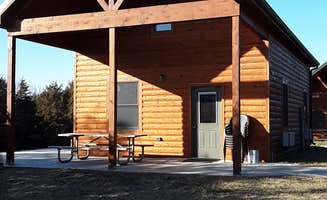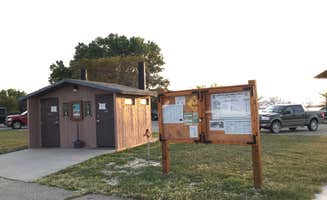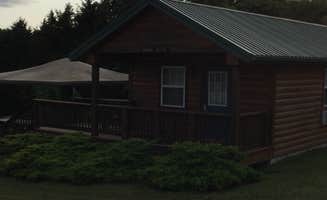Glamping near Randolph, Kansas offers visitors access to the 16,000-acre Milford Lake, the largest lake in Kansas with over 163 miles of shoreline. Located in the Flint Hills region, the area experiences hot summers with temperatures regularly exceeding 90°F and cold winters with occasional snowfall. Most glamping accommodations maintain seasonal operations from April through September, with limited availability during winter months.
What to do
Swimming at designated beaches: At Curtis Creek Park on Milford Lake, visitors can enjoy swimming from rocky shorelines. "We went kayaking and playing on the beach. We booked the buddy sites to have an extra large site beside the beach area and it was worth it," notes a camper at COE Milford Lake Curtis Creek Park.
Wildlife observation: Cedar Point at Milford State Park provides excellent wildlife viewing opportunities. "This park has wildlife to view like the large flock of turkey vultures who live in the dead trees of cedar point," explains a visitor at Cedar Point — Milford State Park.
Horse-friendly camping: Sunset Ridge area offers specialized equestrian facilities while remaining open to all campers. "Has equestrian amenities, but sites are not limited to horse enthusiasts. Any campers welcome," reports a visitor at Sunset Ridge.
Fishing from shore: Multiple access points around Milford Lake allow for shore fishing without a boat. "There were quite a few people fishing off the shore," observes a camper at Cedar Point. The lake contains walleye, crappie, bass and catfish species.
What campers like
Shade coverage: Many campsites provide natural protection from the summer sun. "Sunset Ridge is a small tenting campground alongside sunset cabins. Sunset ridge is nicely shaded. Each site has a covered picnic shelter and grill," shares a visitor at Sunset Ridge — Milford State Park.
Spacious primitive sites: Cedar Point offers larger sites for tent campers. "Cedar point has some very spacious primitive and tent sites. There are also some with electric and water. Some of the sites in this campground have nice water views," notes a camper.
Quick highway access: Some campgrounds provide convenient overnight options for travelers. "Quick, easy, and inexpensive stay right off the interstate. Water and electric on site and easy pull through parking spots. Clean bathroom and shower," reports a visitor at Owl's Nest Campground.
Covered picnic shelters: Several campgrounds feature picnic areas with overhead protection. "Each site has a covered picnic shelter and grill. The sites are nice and spacious," mentions a reviewer at Sunset Ridge.
What you should know
Algae conditions: Water quality issues can affect swimming safety. "Only downside is the blue-green algae made it unsafe to swim but that is not a fault of the campground," explains a visitor at Curtis Creek Park. Check current lake conditions before planning water activities.
Reservation systems: Some locations require online reservations without on-site registration options. "The check in process was severely frustrating. They only do online. So when we got there with little sun left it took 30 minutes to actually reserve the spot," shares a camper at Farnum Creek.
Highway noise: Campgrounds near major roadways experience consistent traffic sounds. "Not very quiet considering the interstate is right next to it," notes a visitor at Owl's Nest Campground.
Seasonal flood impacts: Some facilities may have lingering closures from past flooding events. "Several of the restrooms were still closed due to a flood in 2019," reports a camper at Cedar Point, highlighting the need to verify available amenities before arrival.
Tips for camping with families
Playground access: Curtis Creek offers dedicated play areas for children. "A pit toilet close by and new playground equipment in A loop," mentions a camper describing the family-friendly amenities.
Poison ivy awareness: Parents should supervise children around wooded areas. "If you bring kids keep away from tree trunks as I saw some poison ivy starting to grow at the base of several trees," warns a visitor at Curtis Creek Park.
Privacy considerations: Some sites offer more seclusion than others. "I arrived pretty late, about 8:15pm, and there was no one at the gate when I arrived so I was a little worried, but I pulled up their email that had all of the information and between that and the park signs I was able to easily make my way to my campsite--which was BEAUTIFUL! I stayed in spot A18, and if you are tent camping I would choose that one if you can. It is the last spot in the row of sites and is bordered on two other sides by the lake," advises a Curtis Creek visitor.
Tent camping locations: Designated tent areas aren't available at all sites. "The tent camping area has been closed since 2019 which is disappointing since we were there with a tent in the middle of a bunch of RV's," notes a Farnum Creek visitor.
Tips from RVers
Full hookup options: Multiple campgrounds offer complete services for extended stays. "There are Full hook ups, pull thru and back in sites, so it's convenient no matter what you are driving," explains a reviewer at Owl's Nest.
Contactless check-in: Some locations offer simplified arrival procedures. "I would give this place 3.5 stars for the visual atmosphere, however, given the noise levels from the interstate and highway, I can't give it four. It has lots of trees but they don't seem to do much to block the constant noise. I did like the contactless check-in," reports an RV camper.
Site levelness: RVers appreciate well-maintained parking areas. "They nice level spots and definitely well maintained," shares a visitor at Owl's Nest. This reduces setup time and eliminates the need for additional leveling equipment.




